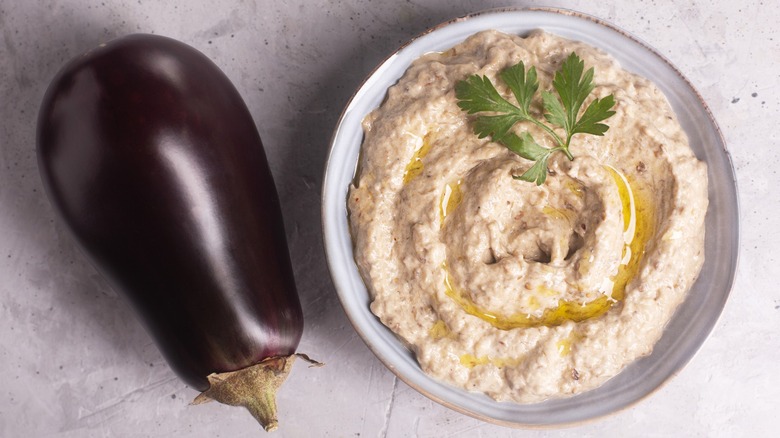The Literal Meaning Of Baba Ganoush, Explained
"Baba ganoush" — two words that, when spoken, instantly invoke images of warm pita dipped into tangy, puréed eggplant and warm spices. You'll be looking up the closest Middle Eastern restaurant and placing an order quicker than you can even finish saying it, and without a second thought. There is one thought, however, that may cross your mind. Whether it's before, after, or while you're eating it, one has to wonder: What does "baba ganoush" mean? Figuratively, it's eggplant heaven. The literal meaning, on the other hand, translates to something slightly less romantic: "pampered daddy."
In Arabic, "baba" is used as a term of endearment — but it's most commonly reserved for dads. "Ganoush" — also spelled "ghanouj," "ghannouj," or "ganoosh" — roughly translates from Arabic to describe someone or something that is flirtatious or spoiled. Thus, whenever you're ordering your plate of garlicky, puréed eggplant and tahini, you're actually asking for a swanky and coy father figure. In the literal sense, at least. That, of course, probably only raises more thoughts and questions in your mind — but most specifically, why? The answer to that can only be explained in a historical context.
Baba ganoush has royal connections
Given its sheer simplicity, one has to wonder how a plate made from eggplant, tahini, and lemon became associated with not only daddies, but pampered ones. Legend has it, the guy who first enjoyed it was one himself. It's believed that baba ganoush was given its name to reference its supposed invention by a member of a royal harem — which, in the pre-Islamic Middle East, was the section of the royal court that consisted of a king's wives, concubines, female attendants, and eunuchs. So, perhaps, instead of thinking of pampered daddies when you're eating baba ganoush, the intention is for you to feel like one. You are eating what was once served to kings, after all.
Since its time served in royal courts, baba ganoush has become as ubiquitous to Middle Eastern cuisine as hummus is. As a result, you'll find many different styles of baba ganoush as you travel across the region, ranging from smoky and smooth to garlicky and chunky. Levant or Eastern Mediterranean styles add in diced tomatoes and onions, while Egyptian and Israeli styles maintain the tahini and lemon but add in a hard-boiled egg. Lebanese styles leave out the tahini entirely, but sprinkle pomegranate seeds or drizzle pomegranate molasses on top, while Syrian baba ganoush swaps the tahini for yogurt for an even creamier and tangier effect. The examples go on, but the name remains.

